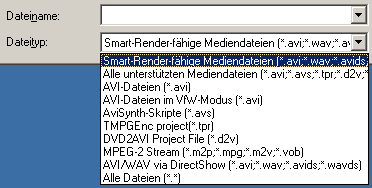| Updates and patches |
Plugins are small software modules with which the abilities of a program can be extended. Like a construction set, there is a basic equipment (the application program as for example AV Adjust) which can be extended gradually by special sets (plugins). Of course only in case that both fits to the other: LEGO blocks with a little bit different knobs would be object to complain because they cannot be put on the other ones. In the same way also universally applicable plugins should have a knob pattern (here called "interface") which is uniform, "usual", and above all no secret.
As for this VFAPI plugins are ideal. They have exactly one task - this is to supply video and audio data to the calling program - and do this in a uniform way which can be looked up everywhere in the Internet. VFAPI was created by the author of the legendary MPEG encoder TMPGEnc, Hiroyuki Hori. The success of TMPGEnc with its well documented VFAPI interface has caused that also other programmers began to write plugins to "teach" the encoder for new file formats. And the best of all is that VFAPI plugins are available system-wide so that also every other program which supports VFAPI can read in the new file formats automatically. In the end these advantages led to the fact that VFAPI is now regarded practically as standard. And it is really the only one which is system-independent because it is not based on the Windows™ interface.
While opening a video or audio file all available VFAPI plugins are displayed in the Drop-down-list "file type" (after the standard file types AVI, WAV, and AVS). In the following example are four VFAPI-Plugins installed: the project readers of TMPGEnc and DVD2AVI, the MPEG-2-Reader by Kazuhiro Mogi, and AV Adjust's AVI/WAV DirectShow Reader:

If you want to open a file with a certain plugin, all what you have to do is to select this plugin in the "file type" list before loading the file.
| Updates and patches |